In 1968, an Italian industrialist and a Scottish scientist started a club to address what they considered to be humankind’s greatest problems—issues like pollution, resource scarcity, and overpopulation. Meeting in Rome, Italy, the group came to be known as the Club of Rome and it grew to include politicians, scientists, economists and business leaders from around the world. Together with a group of MIT researchers doing computer modeling, The Club of Rome concluded that sometime in the 21st century, earth would reach its carrying capacity—that resources would not keep up with population—and there would be a massive collapse of global society.
 In 1972, the Club of Rome published a book outlining their findings called The Limits to Growth. The book became a bestseller and was translated into more than two dozen languages. It had its critics and detractors, but overall The Limits to Growth was incredibly influential, shaping environmental politics and pop culture for years to come. There was a growing sense that limits would need to be put in place in order to regulate populations and economic growth.
In 1972, the Club of Rome published a book outlining their findings called The Limits to Growth. The book became a bestseller and was translated into more than two dozen languages. It had its critics and detractors, but overall The Limits to Growth was incredibly influential, shaping environmental politics and pop culture for years to come. There was a growing sense that limits would need to be put in place in order to regulate populations and economic growth.

But in the midst of the debate, a physicist named Gerard (Gerry) O’Neill suggested a solution—one that would ask us to look beyond planet earth and into outer space.
O’Neill wanted to build vast human settlements in space. And although he wasn’t the first to imagine humans living there, he was the first to come up with technologically feasible designs for habitats.
Over the course of his career, Gerard O’Neill would turn skeptics into true believers, find support from NASA, and start a social movement toward the goal of building human colonies in space.
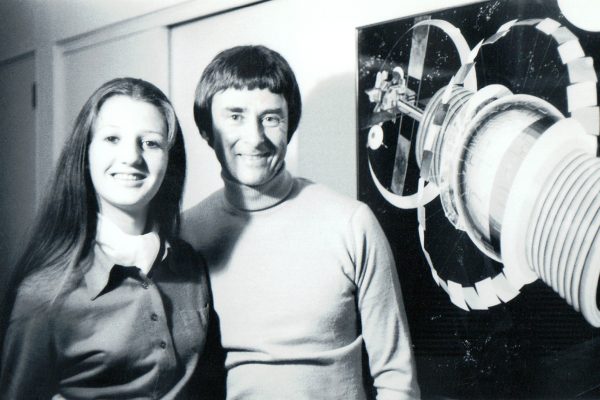
Before he started thinking about space colonies, Gerry O’Neill was a professor at Princeton, with a focus on high-energy particle physics. He designed and built particle accelerators and made a number of important innovations in the field. As a teacher, he was respected by his colleagues and known for getting his students involved in hands-on projects.

In 1969, the same year the first astronauts walked on the moon, O’Neill asked his introductory physics students at Princeton to figure out what made more sense—building human settlements on the surface of another planet or building free floating settlements in outer space. After months of research and calculations, O’Neill and his students concluded that free-floating habitats were superior for a number of reasons.
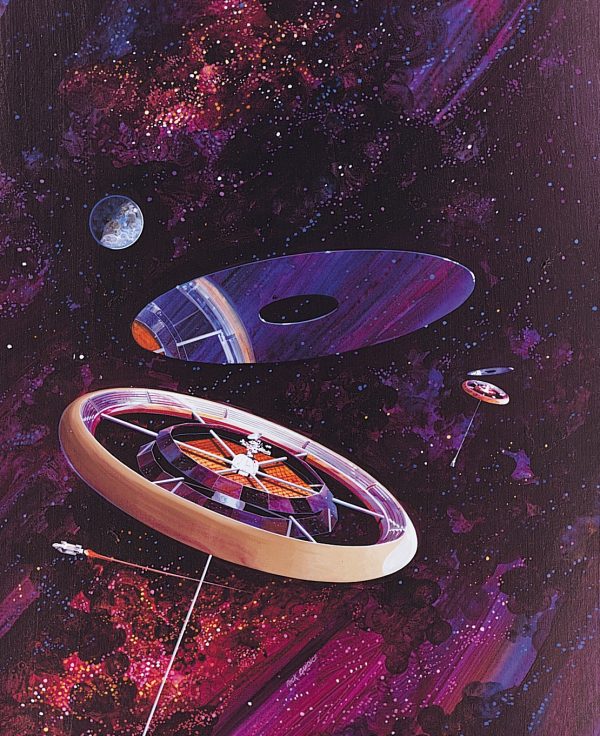
It would be easier, they reasoned, to move things (and people) on and off of free-floating settlements than it would be to move them on and off of a planet. This is because the force of gravity on a free-floating settlement is far weaker than that of an entire planet planet. All planets sit in “gravity wells” that make moving things on and off of them difficult.
On top of that, in outer space, the sun’s energy would be available 100% of the time, obviating the need for other fuel sources.
When the semester ended, O’Neill did not stop thinking about how to build human settlements in space. In fact, he’d only just begun.
O’Neill decided he would build his settlements at a place in our solar system around 250,000 miles from Earth called LaGrange Point 5. Lagrange points are places in space where objects stay put. Which is to say, they stay in stable positions relative to nearby bodies. L5 maintains a position that is equidistant from the Earth and the moon, so a settlement there would always remain in (relatively) close range to both.
O’Neill’s basic designs for habitats were variations on cylinders, spheres and ring shapes. This approach has since been replicated all over science fiction, including in the recent films Elysium and Interstellar.
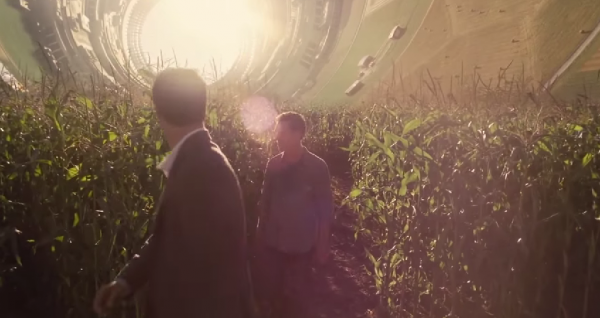
In all of his designs, people would live inside giant sealed tubes that would slowly rotate about a central axis. This rotation would produce centrifugal force roughly equal to the force of gravity on Earth. The inside of the tubes were also large enough to hold idyllic landscapes including rivers, trees, hills, and terraced housing that could hold thousands of people.
O’Neill hoped the first settlement would house 10,000 people and subsequent structures would house up to 3,000,000. The idea was that eventually these settlements could unburden the Earth of a significant portion of its population while also providing our home planet with solar energy, beamed back to the surface via radio waves.
The initial materials would have to be brought into space by NASA’s space shuttle. The shuttle was expected at the time to become a sort of “space truck,” making regular flights to and from space. But O’Neill knew to build on the scale that he imagined, he’d have to get subsequent resources from somewhere with less gravity (the earth sits in a 4000 mile deep gravity well).

The moon was perfect. Its gravity well is only 200 miles deep and the minerals in its rock and soil included everything O’Neill would need to build the settlements. Materials would be mined on the moon and then shot from the lunar surface toward L5 using a type of electromagnetic catapult known as a mass driver. O’Neill even built a working model of one with his students.
Initially, Gerry O’Neill’s designs and ideas got a fairly cool reception from the scientific community. While few questioned the engineering or physics, some were thrown by extreme nature of his proposals. But O’Neill did have early support from a few of his colleagues including the famous physicist Freeman Dyson, who did not always agree with O’Neill’s specific vision, but was nonetheless excited by his friend’s ideas.
 Then, in May of 1974, the New York Times ran a front page article about O’Neill’s ideas, and suddenly there was both academic and general public interest in his work.
Then, in May of 1974, the New York Times ran a front page article about O’Neill’s ideas, and suddenly there was both academic and general public interest in his work.
Later in 1974, his research was published in Physics Today and requests for interviews and speaking engagements began to roll in.
O’Neill even attracted the interest of NASA, which funded a series of studies around his ideas at the Ames Research Center. These studies produced the artist renderings featured throughout this article.
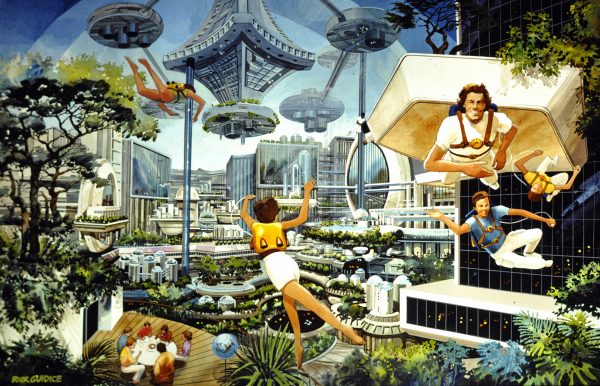
In all of his interviews and lectures, O’Neil talked about space in a whole new way. Space wasn’t a government program open only to elite astronauts. Space was a place— a place for ordinary people to live in and explore.

By 1975, a group called the L5 Society had formed around O’Neill’s ideas and were spreading the gospel of space colonization. L5 was vocal and politically active—publishing a newsletter and lobbying Congress and NASA for an expanded space exploration program.
The group attracted an odd assortment of members, ranging from scientists and space enthusiasts to hippies and science fiction geeks. They even developed a sort of theme song, Home on Lagrange, set to the tune of Home on the Range:
… where the microwaves play, down at three degrees k, and the cold virus never evolved; home, home on Lagrange where the space debris always collects; we possess so it seems, two of our greatest dreams: solar power and zero-g sex.
This somewhat eclectic collection of followers (which included LSD guru Timothy Leary) made it difficult at times for O’Neill to get the government to take his ideas seriously.
Meanwhile many environmentalists outright rejected O’Neill’s ideas, seeing space exploration as an extension of the military industrial complex. Others characterized his colonies as a literal form of white flight.
But no one really disputed the technological feasibility of O’Neill’s designs. And given the fast pace of the space race in the 1960s and 1970s, many people expected space colonies to be on the horizon in decades if not years.
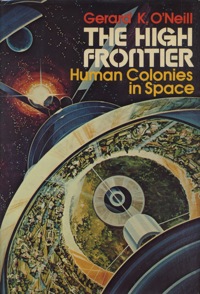 In 1977 all of O’Neill’s research was published into a very readable book called The High Frontier and O’Neill appeared on 60 Minutes with Dan Rather, where he predicted he would see space settlements built in his lifetime. But despite O’Neill’s optimism, this 60 minutes segment marked the peak of mainstream interest in his ideas.
In 1977 all of O’Neill’s research was published into a very readable book called The High Frontier and O’Neill appeared on 60 Minutes with Dan Rather, where he predicted he would see space settlements built in his lifetime. But despite O’Neill’s optimism, this 60 minutes segment marked the peak of mainstream interest in his ideas.
And while NASA had funded some of O’Neill’s work, it became clear to O’Neill in the late seventies that they were not prepared to spend the billions needed to build his settlements in space. NASA’s space shuttles did not become regular and reliable “space trucks” and ended up making fewer flights into space than originally predicted. And in general, NASA became a more cautious and less adventurous organization than many had hoped.
In 1977 O’Neill founded the non-profit Space Studies Institute, which raises money and does its own research on space colonization.
Gerard O’Neill died in 1992 after a long battle with cancer. Now, 25 years after his death, some people think we are on the brink of another space age. Many of the new space visionaries (like Peter Diamandis and Rick Tumlinson) were young men at the peak of O’Neill’s career and some see themselves as carrying out his legacy. Many of these new space entrepreneurs also hope to make a lot of money in space—by mining asteroids and providing commercial flights to “space tourists,” and they believe that private investment, and not NASA, will fuel the next space age.

According to his wife, Tasha, Gerard O’Neill wanted his ashes scattered in a space colony. Tasha and many others believe it won’t be long before this wish becomes a reality.
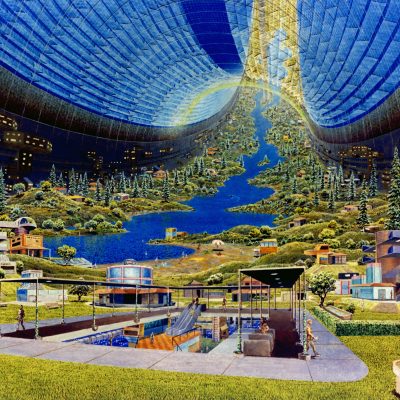

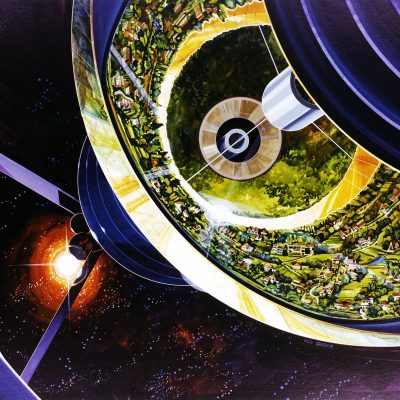
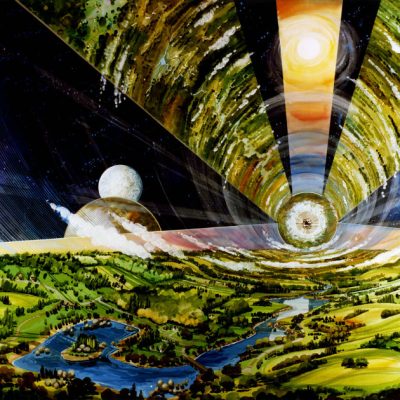
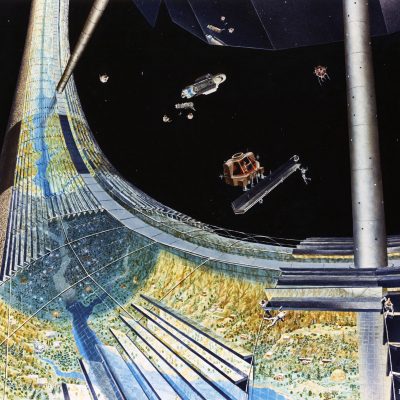
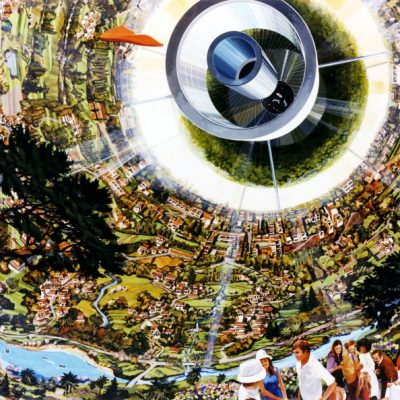



Comments (18)
Share
Really appreciated the use of the Deltron 3030 instrumental in this episode. Who can we thank for this brilliant choice?
Great show with great characters. Always fun to remember what the future used to look like. But… “produce a centrifugal *force*” ?? Come on 99pi! Gotta get the basic science right. It’s worth explaining to your listeners the right way, even if it feels cumbersome for the story. The alternative is perpetual myth.
The Bishop Ring (http://www.iase.cc/openair.htm) Is the largest serious space habitat proposal I’ve ever seen. Bishop wanted to use carbon nanotubes to make a small Ringworld with at least as much land area as India.
Lagrange point L01 would permanently obstruct our view of the Moon, haha
Well done. The audio version is truly worth hearing all the way through. As Douglas Adams once said “Space is Big” so condensing the complexity of The High Frontier concept into a short listenable piece is not easy task. FYI: SSI continues to work on the Engineering, NSS continues their L-5 Society roots public relations and Jeff Bezos of Blue Origin (and the little company Amazon) is yet another of the fellows who has taken O’Neill’s large scale Space Manufacturing to heart for a new generation. Big things take time but correct things that have at their hearts Helping Every Person Everywhere eventually come. Make the future, it’s only just begun. Thanks for a great audio piece.
There was also a movement of Black artists (Afrofuturists) who embraced the idea of space exploration and used it to critique the condition of Black people here on Earth. A lot of interesting fiction and music came out of these ideas. Octavia Butler, Parliament-Funkadelic, Warp 9, Deltron (of course), Jeff Mills.
On behalf of the O’Neill family I’d like to thank producer Katie Mingle for her dedication to get the facts straight and to craft such a wonderful piece about Gerry’s contribution to our future in space. I truly enjoyed working with her on this.
Well done.
“This approach has since been replicated all over science fiction, including in the recent films Elysium and Interstellar.”
Don’t forget Japan’s Universal Century Gundam animated works starting in 1979 which mad extensive use of the idea of the colonies.
Thank you for a great piece Katie and company. Your command of the new digital production space and your sensitivity to facts, first-person conversations, and human psychology can revisit this story to 60 Minutes, Nova, The Situation Room, The Tonight Show…. Go for broke.
Are you sure you only read the articles?
Great episode and superb article! I love all the concept art.
No link to the sung version of Home on Lagrange (The L5 Song)? I’m disappointed, I was hoping to hear that song sung in full, but alas all I can find is the lyrics…
Unfortunately the L5/NSS group morphed into a sad caricature of the looney far-right. This marginalized them more than anything.
When this program started I was really thrilled that a “mainstream” podcast was mentioning Limits To Growth and perhaps we were going to have an actual conversation about the insane ways our species wastes non-renewable resources. Sadly, it turned out just to be an intro for yet another techno-fantasist boondoggle. The last thing we should be doing is encouraging the asinine “We screwed it up! Let’s just run away from our planet!” meme.
Your opinion has some merit in the cases of White Flight shown in movies like Elysium but – technically and honestly speaking – the point of **O’Neill’s** work was not rich folks looking down on everyone else left behind. The High Frontier is fully rooted in the uplifting of ALL people here on Earth and takes great pains to show that the big part of this is not to flee but to create the tools that will make all people – ESPECIALLY those who are suffering from lack of food and water and personal power to chance their plight – have an equal footing. Really, it is. I sincerely hope that you will look a bit deeper into O’Neill’s High Frontier (not just looking at others who use the huge space habitats for the fun or spectacle of them) and in so doing you may find that this is not quite what a 20 minute overview may have pointed your feelings to. If it was only about big space colonies then I believe – from my contacts – that O’Neill would not have worked so hard on the details of the complete system. His goal was far bigger than pretty pictures… The High Frontier spells that out *very* clearly as a way to help the poor while also helping those who have the power to make it happen (it is an expensive project, so rich folks are required – but the poor are big winners, by design). I hope you’ll look to that by perhaps reading The High Frontier book for yourself, if only to be able to say that you personally performed your due diligence to prove that your reaction was 100% valid.
Hi Robert, thanks for your reply.
I’m sure O’Neill had the very best of intentions and perhaps you’re right and I should read the book (although life is brief and there are oh-so-many books), but from what I heard in this program I was very unimpressed, as I really fail to see how building something as prodigiously costly as a huge space station would be economically and politically feasible. You’re saying it wouldn’t just be rich people, really? The way the the economy is now? Maybe I’m just dense, but in what way would this sort of thing be available to any but the most criminally wealthy? You don’t have to summarise the book, but some rough idea of how this is economically possible would perhaps change my mind.
It is enormously expensive to launch material into space (yes, including using a mass driver) and even more expensive to build things in space, (don’t even get me started on the flawed economics of space mining). This doesn’t even take into account how hard it is to keep humans alive in an environment which has effectively no value to us. The Earth’s environment provides 75% of all our species’ wealth, for free. We don’t get that discount in space. If we want water, we have to transport it or make it, if we want energy, we have to pull it from the sun, (as I’m sure you know, solar power is highly diffuse and expensive as heck to store, with a relatively low EROI even on Earth, the sheer costs of building an array that would power the high-tech lives of some 10,000 people in space as well as a massive station providing that 75% needed for sustained human life is approaching the domain of fantasy). We need shielding from cosmic radiation, artificial gravity, food and a thousand other things (apparently O’Neill didn’t know that people cannot become tumescent in zero-G either). Yes, currently we can currently supply all that for a couple of people in LEO at an extremely high cost, but that is all built off the back of our current limited supply of cheap non-renewable energy and I really don’t see how we can provide that for anything like the kinds of numbers that would be required to mitigate the ecological crisis currently underway across the planet.
But perhaps I’m being unfair and, at the time this was written, this was all in fact feasible. I’m sympathetic to that, Carter putting the solar panels on the roof of the White House and all. Unfortunately, that was 40 years ago and we have burned through quite a lot more of the environmental bounty we were provided with since then. Taking masses of people into space takes gargantuan amounts of energy and money which, with a population of more than seven billion, dwindling energy stocks and a planet in the throes of irreversible ecological collapse, seems to me to be a colossal waste of time and resources.
More fundamentally, the High Frontier idea seems entirely designed to perpetuate the tragically destructive infinite growth meme (I mean, it’s right there in the name, and I could spend all day talking about the silliness of the “frontier” myth), all in all taking precisely the wrong lesson from the LtG (which is flawed in the details, not in the overall point). We live on a limited planet, and the laws of energy and thermodynamics do not owe us any favours. We can accept that and reduce our energy usage, recognizing that it is fundamentally not possible for everyone on Earth to live like a middle-class U.S. suburbanite (the U.S. currently consumes 25% of all the planet’s resources with 5% of the population, it doesn’t take a math whiz to see the problem there), or we can continue to desperately search for excuses which will allow us to delude ourselves that we’re off our self-made hook until we wake up one day and discover that all our species-wide follies have come home to roost.
I’m aware this is currently an unpopular opinion, one of the great secular points of faith, greater and deeper even than the “Christian-rapture-by-robot-brain” Singularity Cult that goes unquestioned these days is the “caves-to-the-stars” meme, born out of the very understandable human urge to wander and expand and grow coming crashing up against the hard limits of physics. I sympathise, it’s an emotive and powerful dream, and maybe hundreds of years from now some of us will venture out in something very like what O’Neill had proposed (though I doubt it), but for the forseeable future we are inescapably a part of this planet, and our desperate desire to deny this fact will only make the realisation that we were dreaming of something that could not be all the more painful the longer we deny our present reality.
Tim Sharp misses a few critical ideas about my dad’s work and should certainly read the book. He says “We need shielding from cosmic radiation, artificial gravity, food and a thousand other things (apparently O’Neill didn’t know that people cannot become tumescent in zero-G either).”
1) Cosmic shielding is an integral design of the habitats’ hulls
2) Artificial gravity is provided via rotation (ever seen 2001? it doesn’t even need to be all that large a circumference for this to work)
3) Food is grown in farming pods or sectors or whatever, depending on which habitat design is built
4) Resources are plentiful in space… there are already companies such as Planetary Resources working on retrieving those that aren’t sitting pretty on the moon (where mass drivers can do it cheaply).
5) And finally, solar power is certainly feasible on a space habitat. There isn’t even a need for much storage because the sun is aways shining on you, undiluted by atmosphere.
As for rich vs poor, I couldn’t say what’ll happen since that’s likely to be tied up in political factors, but though dad wanted space to be open to all (as do I), to me the first concern is this:
Nice as the Earth is, it’s a very vulnerable basket into which to be holding all our eggs. We could be wiped out by a massive asteroid (or nuclear/bio war) all too soon. In my view, we’ve got to spread off this planet or our days are likely numbered. (Neal Stephenson’s novel Seveneves tells a pretty interesting story of what might happen if we aren’t ready when that day arrives.)
Hi Elinor, thanks for your response and I hope you do not take my critiques of the conceptual ideas in play here as anything like a personal criticism of your father, who, from what I heard in this program and from what little digging I did, sounded like he was a wonderful man. I also thank you for providing more details from the book which, again, I confess I have not read. I’ll go through your points one by one, followed by a few more of my thoughts.
1) “Cosmic shielding is an integral design of the habitats’ hulls”
I’m interested by this, as I was under the impression that NASA had still failed to crack any kind of shielding that would keep individuals outside of the magnetosphere safe within acceptable limits of exposure. There was a competition recently held for students around the country to propose ideas (with prize money!), and I believe a partnership is underway with MIT and CIT to research this and other long-term space habitation issues further, but as far as I know, nothing has yet achieved the standards required. Was there another concept that Mr O’Neill had some forty years prior that NASA is unaware of?
(link 1) http://www.nasa.gov/press/2015/april/nasa-awards-radiation-challenge-winners-launches-next-round-to-seek-ideas-for
(link 2) http://www.nasa.gov/press-release/nasa-establishes-institute-to-explore-new-ways-to-protect-astronauts
2) “Artificial gravity is provided via rotation (ever seen 2001? it doesn’t even need to be all that large a circumference for this to work)”
I have no disagreement with the use of centrifugal force to simulate gravity, but I do question the size dynamics at play. According to an article I read in Popular Mechanics, at a size of anything less than a football field, the long term effects on the human body would appear to be unpleasant at best. Yes, the ISS is currently about that big, but it is mostly solar panels, the modules themselves are quite small (this feeds into a later point I’ll have about scale/energy).
(link) http://www.popularmechanics.com/space/rockets/a8965/why-dont-we-have-artificial-gravity-15425569/
3) Food is grown in farming pods or sectors or whatever, depending on which habitat design is built
Again, I’m not going to disagree that with hydroponics it is possible to grow food in space (and indeed this has been done on the ISS, even with the limitations of microgravity), but I also have to stress the scale and energy requirements needed if this is to be truly self-sufficient for a massive space station, as they are positively gargantuan. You need to constantly provide water, heat, humidity, light and nutrients, as well as control for healthy microbial activity, (molds are a problem even in space). This is all potentially do-able, but I don’t think it’s as simple as just building “farming pods or sectors or whatever” and once more I have to stress the enormous cost of materials and energy that would be required to make this truly self-sustaining. That 75% free stuff thing we get from Earth is no joke, it takes an insane amount of money and energy to keep even four or so people alive in LEO as we currently do. The costs are truly staggering once you start talking about THOUSANDS of people.
(link) http://science.howstuffworks.com/space-farming.htm
“4) Resources are plentiful in space… there are already companies such as Planetary Resources working on retrieving those that aren’t sitting pretty on the moon (where mass drivers can do it cheaply).”
OK, now we’re really getting into the meat of the issues here. From everything I’ve seen and read, it seems to me that space mining is a ludicrously cost-prohibitive exercise. Yes, technically resources are “plentiful” in space, but there is something even more abundant in space, and that is nothing. In other words, you need to expend crazy amounts of energy to get anything up into space to begin with, even more to send your mining robot (I assume we’re talking robots here) out to an asteroid, more again to capture the rock and still more to process it (or maybe they just collect stuff there and take that back, either way, the costs are insane).
The vast majority of asteroids in our solar system (that aren’t ice, which is most of them) are highly homogeneous and are not ore-rich in anything like the densities required to be economically viable. This also doesn’t address how you then extract and process these materials in space to be used as construction materials without going bankrupt (are we talking about oceans of construction bots, or space construction workers? Either way, the scale required is fantastic, in the true meaning of the word).
Yes, PR is looking at some hunks of platinum, but even then the current cost of platinum is far less that what you would need to break even on a space mining operation, not to mention if they did get massive quantities of the stuff it would naturally depress the cost, which would make it even more infeasible.
The idea of resources “sitting pretty on the moon” is also a somewhat dubious proposition to me. You’re still looking at massive costs for getting the materials up to the moon establishing a mining colony and massive costs for keeping the builders/miners alive (or having functional robots doing their stuff up there, forty years after these proposals and we still lose robots in space all the time and they are extremely expensive to replace.) All in all, I’m pretty dubious about us mining much but water on the moon (maybe a solution for that particular space station issue!).
(link 1) http://www.huffingtonpost.com/dr-sten-odenwald/the-myth-of-space-mining_b_8415992.html
(link 2) http://www.adamsmith.org/blog/economics/theres-a-very-slight-problem-with-asteroid-mining
(link 3) http://motherboard.vice.com/blog/the-problem-with-asteroid-mining
(link 4) http://physics.ucsd.edu/do-the-math/2011/10/stranded-resources/
(link 5) http://www.homepages.ucl.ac.uk/~ucfbiac/Lunar_resources_review_preprint_accepted_manuscript.pdf
“5) And finally, solar power is certainly feasible on a space habitat. There isn’t even a need for much storage because the sun is aways shining on you, undiluted by atmosphere.”
Of course, solar power is technically feasible, but the size of the array required to meet the needs of the enormous space station you would need to:
a) Be big enough for artificial gravity to work, (with the habitable ring of the station at least larger than a football field)
b) Mitigate all the costs required to keep hundreds or thousands of people on board alive
As I mentioned in my first point, the ISS is currently the largest station we have in orbit and it is MOSTLY solar panels and needs all of them to keep a positively minuscule number of people alive (and their food is primarily packaged stuff, not farmed, and they live in hideously cramped conditions, no luxuries for these guys/gals, a far cry from the pretty ring illustrations). Solar energy is awesome, but it is also highly diffuse and so to collect enough energy to power the kinds of scales of activity and habitations discussed here is an extremely expensive proposition. You would need to get tons and tons of silicon, glass and rare earth metals up in space to power it, (or take it from asteroids and process them I suppose? There’s that cost thing again). None of these resources are free, and with the economics required I think we are beginning to approach the domain of utter infeasibility. I’d actually buy it more if the thing was nuclear powered, and even then I would have serious questions about the costs involved.
“As for rich vs poor, I couldn’t say what’ll happen since that’s likely to be tied up in political factors, but though dad wanted space to be open to all (as do I),”
This is kind of the crux of it, though, isn’t it? Everything is politics. The human race is not a platonic ideal. We can’t even get our act together on dealing with the global climate, or stop ourselves from obliterating swathes of the planet’s biomass and, as this program itself implied, pretty much the only people looking at going en-masse into space these days are plutocrats. There are also already deep legal issues brewing as to the “ownership” of space. Nobody is seriously talking these days about it being “open to all” and, really, how could it be? The costs required to get even a kilo into space are prohibitive, let alone keeping a human being alive up there, so of course only governments or the ultra-rich are going to be over-represented, we’re hardly going to be building ghettos in space anytime soon. I mean, technically, Antarctica (which is far more economical/habitable than space) is kind of “open to all”, but you don’t see swathes of lower-income people setting up shop there either, and you probably never will, barring a potentially human-species-killing shift in the climate.
(link 1) http://news.nationalpost.com/news/who-owns-the-moon-space-lawyers-increasingly-needed-for-legal-issues-beyond-earths-atmosphere
(link 2) http://www.thespacereview.com/article/2130/1
“Nice as the Earth is, it’s a very vulnerable basket into which to be holding all our eggs. We could be wiped out by a massive asteroid (or nuclear/bio war) all too soon. In my view, we’ve got to spread off this planet or our days are likely numbered. (Neal Stephenson’s novel Seveneves tells a pretty interesting story of what might happen if we aren’t ready when that day arrives.)”
Well, much as we may like it or not, our days as a species are numbered regardless in the long run and here, finally, is my deepest point, which I will reiterate and expand on from my previous post.
Our species’ theatrical narrative of infinite space travel and expansion is by and large, on the real world we live on right now, not in a science fiction book or movie, a fantasy. We are tied to this planet, by biology, by ecology, by economics, by politics, by who we are as a species and what this universe is like. We have allowed ourselves to be blinded by an obsession with technological miracles at the cost of the only large scale habitat we have, or will ever have, for the foreseeable future at least. Our evolutionary drive to expand like a virus, to grow infinitely, is now meeting the petri-dish limits of our planet. Every year we consume more and more non-replaceable resources quicker and quicker, we burn millions of years worth of stored sunlight, we tap into aquifers that will take millenia to replace, we acidify our oceans, we drive thousands of species to extinction, we deplete the limited reserves of phosphorus, fossil fuels, helium etc we have available to us, we poison our rivers and treat our atmosphere like a sewer. We’re now essentially locked into oceans rising, mass biodiversity collapse, Florida becoming uninhabitable salt-marsh, continent-wide droughts, just to name a few of the consequences of our species-wide stupidity. None of these points are scientifically controversial. And the engine of all of this is our pathological hunger to grow more, bigger, wider, larger, deeper, infinitely, on a finite planet, which is the only world in our solar system we have ever evolved to survive on (and even then, large swathes are uninhabitable, no need to go to space for that!). The caves-to-the-stars meme is the purest expression of this hunger, when faced with the reality of the mess we have made, it seems all this thinking can come up with is “let’s just run away to space and not change at all!” I hope I’ve enumerated just a couple of the deep problems with this line of thought. Entertaining fantasies of space colonies free of the realities of politics, economics or who we are as a species, in the end functions in a similar way to a cult and stops people from truly grappling with what we have to deal with on this planet, instead encouraging them to look up to the heavens where they will all find their supposed salvation, not looking around and grappling with this world of crude matter and banality and sacrifice and compromise and humanity, which is the only real world we have.
I suppose, at the heart of it all, my points of contention are purely about grappling with the world and our species as they are, not as we wish they would be. Yes, it is perhaps technically possible to do the stuff mentioned in this program, but it’s also technically possible for us to build a giant statue of a duck the size of Iceland made of aluminum. It’s not a matter for the technical requirements, it’s about economics, politics, and all those other boring but necessary components of the human experience.
I know I probably won’t convince you, and I hope I have not offended you with my criticisms. I only hope that some people reading this might take a second or two to think about this conversation and ask some deeper questions beyond the science fiction dreams on offer in this particular program. I care deeply for our species (as dumb as we are) and this planet, we both seem to agree on that, we only disagree on the realistic course of action available to us.
Finally, I want add that I enjoy the fact we can have a dialogue about these things, as honest non-partisan discussions about space travel/habitation and its promises/realities are surprisingly rare online.
A few final links for the curious:
(link 1) http://physics.ucsd.edu/do-the-math/2011/10/why-not-space/
(link 2) http://thearchdruidreport.blogspot.ca/2013/09/which-way-to-heaven.html
(link 3) http://www.antipope.org/charlie/blog-static/2007/06/the_high_frontier_redux.html
(link 4) http://boingboing.net/2015/11/16/our-generation-ships-will-sink.html
Totally misspelled your name there by the way Eleanor, blame it on late night posting!